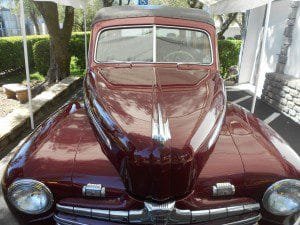Who doesn’t like running across a magnificent old woody automobile? Especially one of those 1946 Ford Woodies. You may remember the tales of the woody and the surfers along the California beaches. Songs have been written about woody cars.

There was a time when a “woody” was actually made from wood. The more modern woodies used wood grain vinyl which, although look good, aren’t the real thing.
There were reasons for the conversion to simulated wood grain steel and they included cost and durability. Interestingly enough, when the Woodies were first built, the cost of wood was less than that of steel. At that time it was not only a stylish touch but cost saving as well. Most of the woodie cars seen are wagon type vehicles but some are also convertibles. The style became quite popular and local craftsmen and carpenters even offered to restyle cars using wood.
The car we are highlighting in this story is a 1946 Ford Woody Wagon and the wood is genuine. This car has had disc brakes, power steering and air conditioning added. As most know, the American automakers were banned from building and selling civilian cars during World War Two, in favor of military vehicles, and when the the war ended they dove back into civilian vehicle production in a strong way.

The “Woodies” and the great way they looked helped bring buyers back into automobile dealer showrooms after the war. Several car makers were building woodies. Chevrolet Woodies were a good example as well. It had been a long time since someone could purchase a newly designed car. The 1946 Ford Woody was a great answer to the pent up buyer demand in 1946. The design concept, comfort and safety features of the vehicle are fantastic.
The National Woodie Club, and there are “woody car clubs” all around the United States says that the “woodie is a special kind of car, which deserves special recognition“. This is the stated goal of the club and we couldn’t agree more. The National Woodie Club has chapters throughout the U.S.

Woodies were first offered in the U.S. during the 1930’s. The original idea of using wood on car bodies came to be in the early 1930’s. Plymouth came out with a woody station wagon in 1934. I believe this was the first woody car built.
Automobiles had been “restyled‘ in ways for many years and dating back to the 1920’s and 1930’s, cars would often, at least among owners who could afford to do it, be restyled. Curtains could be added and other interior and exterior decorative touches. Beginning in the mid 1930’s, the automakers took this step forward with their woody cars.
You may also be interested in our article and photos of Old Ford Trucks of the 1930’s and the 1948 Ford Super Deluxe Eight Convertible
Production of woody cars started to decline dramatically in the 1950’s but not entirely. Plymouth and Buick halted all woody production but both Ford and Mercury continued on. One of the things that people started to realize was that wood could catch fire, not to mention potential termite problems. Mostly for safety reasons, the woody cars that Ford continued to build after the competition stopped, used imitation wood grain. The wood look didn’t die out entirely after Ford stopped building the models. The Dodge Caravan series offered wood grain steel well into the 1990’s.

The 1946 Ford Woody Wagon shown here is an exceptional vintage automobile. This car at one time was used in the Philippines at the U.S. embassy after World War II. The vehicle was new when it was shipped to the Philippines. The car was used by both General Eisenhower and General MacArthur after the war. The wood on this particular automobile was restored by local craftsmen. The car reportedly drives like new. The restored car features a 350 TPI engine. The TPI stands for “Tuned Port Injection“. Injectors are placed in each individual cylinder’s intake port giving the engine much better response and economy. Essentially, the torque is enhanced by a system of tuned runners.
The hot collector “woodies” today are the original vehicles like the one shown here built in the mid 1940’s and excellently restored. It’s not very often you see a vintage car like this 46 Ford Woody in this degree of excellent restoration.


